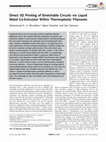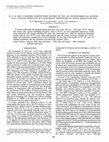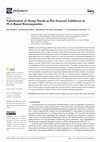Papers by Mohammad Khondoker

With the inclusion of a syringe pump, needle-based dispensing of liquid metal was executed using ... more With the inclusion of a syringe pump, needle-based dispensing of liquid metal was executed using the third input of the tri-extruder system. Therefore, the extruder system is capable to co-axially extrude liquid metal alloy within an encapsulating polymer shell, in this case, SEBS. Hence, an extremely stretchable and flexible conductive wire with a continuous stable core of liquid metal is produced which does not require any post-processing and an extra sealing step. To demonstrate the capacity of this tri-extruder system, a 2D spiral pressure sensor was printed on an SEBS substrate. A 3D inductor was also printed and characterized to measure circumferential strain by monitoring the change in inductance. An immediate drawing process was also found to be useful to produce liquid metal based microwires (~50 μm) which are stretchable up to 400% without any noticeable mechanical and electrical loss. This opens up new possibilities to utilize this smart extruder system and fabricate microfluidic devices in a very simple method without needing a clean-room environment.
3D Printing and Additive Manufacturing, 2019
Abstract Fused deposition modeling (FDM) printers are some of the most common additive manufactur... more Abstract Fused deposition modeling (FDM) printers are some of the most common additive manufacturing (AM) systems in use today. One of their most significant drawbacks compared with alternative AM ...
Progress in Additive Manufacturing, 2019

Advanced Engineering Materials, 2019
Liquid-metal alloys are now extensively used for stretchable electronic applications due to their... more Liquid-metal alloys are now extensively used for stretchable electronic applications due to their superior electrical conductivity, non-toxicity, and mechanical stability in micro-channels. Needle-injection and direct-writing are the most popular techniques for patterning micro-structured liquid metal alloys. However, embedded channels often require a very high pressure to inject liquid-metal, and direct writing by dispensing is relatively complex due to the low viscosities and high surface tension of the metal which cause liquid to normally dispense in droplets rather than a stream. In this work, a technique to co-axially extrude liquid-metal alloy within an encapsulating cover fluid has been presented to obtain a continuous stable stream of liquid-metal. Fused deposition modeling (FDM) 3D printing has been adapted to co-extrude a liquid-metal core with a shell made from a thermoplastic elastomer. A custom extruder system is used to directly produce conductive micro-wires (diameter: %25 μm) of liquid-metal having an insulating shell of styrene-ethylene-butylene-styrene which can be stretched up to four times the original length without any noticeable mechanical and electrical loss. The system is capable of printing in-plane conductive pathways as well as out-of-plane functional devices with direct-stable encapsulation of liquid-metal wires. This technology has been successfully used to print 2D-pressure and 3D-strain sensors. Three-dimensional conductive micro-structures embedded in elastomers have a great potential for uses in flexible and stretchable electronics applications. [1] Liquid metals (LM) with superior conductivity have gained popularity among the research community because their conductive structures embedded in elastomers can withstand repeated stretching and bending without any noticeable electrical or mechanical loss. [2] Although mercury (Hg) was initially used in this field, [3,4] recently its use has been avoided due to its toxicity. [5,6] In the last decade, gallium-based, non-toxic, [7] LM alloys have been applied in numerous applications where uninterrupted electrical conductivity at high mechanical strain is necessary. [1,2,8] There are two widely used gallium-based LM alloys: eutectic gallium indium (EGaIn) and Galinstan. EGaIn is an eutectic alloy of gallium (Ga) and indium (In) with a typical composition of 75.5% Ga and 24.5% In, having a melting point of 15.5 C. [9] Galinstan represents a family of eutectic alloys of different compositions of Ga, In, and tin (Sn) without a generic melting point. However, the most common form of Galinstan has a composition of 68.5% Ga, 21.5% In, and 10% Sn and a melting point of À19 C. [9] Both classes of LM alloys show similar physical properties. Currently they are considered to be superior electrical conductors for extremely stretchable electronics such as wearables and mechanically tunable antennas because these functional devices can be integrated into non-rigid substrates like textiles, clothing and sensors. [10-12] These LM alloys have a very high electrical conductivity (%1/16th that of copper [13]) compared with most electrically conductive inks or composites, and their ability to strain while remaining conductive is limited primarily by the mechanical properties of the surface or material to which they are bonded. When exposed to air, gallium alloys form a "skin" of gallium oxide, [14] which helps pin the metal to different surfaces. Unlike electrically conductive composites, these LM alloys are not as susceptible to large resistance changes at high elongations due to the separation of conductive fillers. Rather, the LM alloy deforms to fill the volume in which it is contained. The most common fabrication techniques of LM-based microstructures include stencil printing, injection into microchannels, direct writing, and droplet deposition. [1,13] The low inherent viscosity of gallium based LM alloys, combined with non-Newtonian behavior caused by the native gallium oxide layer, makes direct extrusion of the unmodified material exceptionally difficult to achieve, although one recent solution that holds some promise involves the combination of micro-particles with LM alloys to form thixotropic pastes. [15] Mohammed et al. successfully printed liquid metal based flexible electronics, [16] however, they used a suspension of liquid metal particles and it required an additional sintering step. Zheng et al. demonstrated directly printedcircuits-on-paper flexible electronics using a low-cost, simpler technique which can only process 2D circuitry without a sealing material. [17] Lei et al. used a liquid metal alloy (Bi 35 In 48.6 Sn 15.9 Zn 0.4) to print 3D metal structures via liquid phase 3D printing which does not utilize a sealing material. [18] Regardless of the patterning method, for all actual end

Rapid Prototyping Journal, 2018
Purpose This paper aims to target to print functionally gradient materials (FGM) devices made of ... more Purpose This paper aims to target to print functionally gradient materials (FGM) devices made of immiscible polymers in multi-material fused deposition modelling (FDM) systems. The design is intended to improve adhesion of dissimilar thermoplastics without the need for chemical compatibilization so that filaments from many different sources can be used effectively. Therefore, there is a need to invent an alternative solution for printing multiple immiscible polymers in an FDM system with the desired adhesion. Design/methodology/approach In this study, the authors have developed a bi-extruder for FDM systems which can print two thermoplastics through a single nozzle with a static intermixer to enhance bonding between input materials. The system can also change the composition of extrudates continuously. Findings The uniqueness of this extruder is in its easy access to the internal channel so that a static intermixer can be inserted, enabling deposition of mechanically interlocked ext...
Smart Materials and Structures, 2016
Fabrication methods and applications of microstructured gallium based liquid metal alloys View th... more Fabrication methods and applications of microstructured gallium based liquid metal alloys View the table of contents for this issue, or go to the journal homepage for more 2016 Smart Mater. Struct. 25 093001

Volume 2: Advanced Manufacturing, 2016
Fused Deposition Modeling (FDM) is a popular style of additive manufacturing (AM) where a 3D obje... more Fused Deposition Modeling (FDM) is a popular style of additive manufacturing (AM) where a 3D object is fabricated by a molten material deposited into successive 2D layers. Multi-material 3D printing is particularly challenging due to poor adhesion between dissimilar plastics. The majority of currently available multi-material printers use separate nozzles for each material. Therefore, they are incapable of producing devices made of functionally gradient materials (FGM). FGM is a special class of engineering material exhibiting spatially inhomogeneous content, which tailors the material for specific functional and performance requirements. In this work, we present the design and characterization of a bi-material co-extruder system. This specialized extruder is capable of printing two thermoplastic materials through a single nozzle and is also capable of altering the composition of the deposited material while printing. It is also exceptional in that the internal structure of the hot ...

International Journal of Precision Engineering and Manufacturing, 2012
This paper reviews recent advancement of microwave (MW) assisted manufacturing technologies. Beca... more This paper reviews recent advancement of microwave (MW) assisted manufacturing technologies. Because MW energy interacts with materials in unique ways, MW assisted manufacturing technologies have the potential to develop entirely new or enhanced manufactured products and materials as well as new approaches for producing such materials. There have been various fields MW technologies have been applied: material processing of ceramics, polymers, metals, carbon nanotubes and composites; machining; synthesis of organic and inorganic compounds; waste remediation and environmental applications; solvent extraction from foods and bioproducts. This review introduces some fundamental knowledge of MW and current status of MW applications focusing on manufacturing technologies. Also, some suggestions for future research are addressed.

SPIE Proceedings, 2013
ABSTRACT A previously synthesized silver nanoparticle based conductive silver ink was used in thi... more ABSTRACT A previously synthesized silver nanoparticle based conductive silver ink was used in this work to print conductive electrodes on cellulose electro-active paper (EAPap) by using an inkjet printer. Then, Inkjet printed cellulose EAPap experienced a post-deposition heat treatment-sintering process to enhance electrical conductivity of printed electrodes by converting those printed patterns into continuous metallic state. The dependences of electrical bulk resistivity of printed electrodes on both sintering temperature and sintering time were checked. It was found that, higher sintering temperatures and longer sintering process result lower resistivity. In addition, the uniformity of the thicknesses of printed electrodes through transverse direction and the relationship between thickness and the number of printing also had been analyzed. Those printed electrodes also showed very good adhesion on cellulose EAPap.

SPIE Proceedings, 2012
ABSTRACT This paper investigates the feasibility of conductometric glucose biosensor based on glu... more ABSTRACT This paper investigates the feasibility of conductometric glucose biosensor based on glucose oxidase (GOx) immobilized TiO2-cellulose hybrid nanocomposite. TiO2 nanoparticles were blended with cellulose solution prepared by dissolving cotton pulp with lithium chloride/N, N-dimethylacetamide solvent to fabricate TiO2-cellulose hybrid nanocomposite. The enzyme (GOx) was immobilized into this hybrid material by physical adsorption method. The successful immobilization of GOx into TiO2-cellulose hybrid nanocomposite via covalent bonding between TiO2 and GOx was confirmed by X-ray photoelectron analysis. The linear response of our propose glucose biosensor is obtained in the range of 1-10mM with correlation coefficient of 0.93. Our study demonstrates TiO2-cellulose hybrid material as a potential candidate for an inexpensive, flexible and disposable glucose biosensor.
Synthetic Metals, 2012
ABSTRACT Flexible and transparent cellulose-indium tin oxide (ITO) layered (CITOL) films were fab... more ABSTRACT Flexible and transparent cellulose-indium tin oxide (ITO) layered (CITOL) films were fabricated by coating ITO nanoparticle solution on transparent cellulose films using a simple spin-coating method. Surface resistivity and transparency of the films were investigated by means of a two-point probe station and UV–Vis spectrophotometer. Electrical and optical characteristics of CITOL films strongly depend on the ITO nanoparticle concentration. The surface resistivity of CITOL films decreased whereas the optical transmittance increased with increasing the ITO concentration. The coated ITO layer was securely attached to the surface of cellulose. Details about the adhesion and characteristics of the films are illustrated. The flexible CITOL film can be used as an optoelectric material for flexible electronics and display devices.

Applied Physics A, 2012
Silver nanoparticles with size less than 50 nm were synthesized from silver nitrate, polyvinylpyr... more Silver nanoparticles with size less than 50 nm were synthesized from silver nitrate, polyvinylpyrrolidone (PVP) and ethylene glycol, where these chemicals acted as metal precursor, stabilizer and reducing agent, respectively. Then a conductive silver ink was prepared with a suitable solvent by adding a viscosifier, hydroxyethyl-cellulose (HEC), and a surfactant, diethylene glycol (DEG). The combined effect of both viscosifier and surfactant on the physical property of the silver ink was analyzed by measuring the contact angle of the silver ink on a cellulose film. Moreover, the influences of PVP molecular weight and reaction temperature on the size of the silver nanoparticles were analyzed. Then the silver ink was coated on the cellulose film by spin coating and the effects of different solvents, sintering temperatures and solid contents on its electrical resistivity were examined. It was found that, with 50 % co-solvent of deionized water and DEG and solid content of around 50 %, the silver ink exhibited the lowest resistivity. This ink can be used for inkjet printing of conductive patterns on cellulose films.

Polymers
Sourced from agricultural waste, hemp hurds are a low-cost renewable material with high stiffness... more Sourced from agricultural waste, hemp hurds are a low-cost renewable material with high stiffness; however, despite their potential to be used as low-cost filler in natural fiber reinforced polymer biocomposites, they are often discarded. In this study, the potential to add value to hemp hurds by incorporating them into poly(lactic acid) (PLA) biopolymer to form bio-based materials for packaging applications is investigated. However, as with many plant fibers, the inherent hydrophilicity of hemp hurds leads to inferior filler-matrix interfacial interactions, compromising the mechanical properties of the resulting biocomposites. In this study, two chemical treatments, alkaline (NaOH) and alkaline/peroxide (NaOH/H2O2) were employed to treat hemp hurds to improve their miscibility with poly(lactic acid) (PLA) for the formation of biocomposites. The effects of reinforcement content (5, 10, and 15 wt. %), chemical treatments (purely alkaline vs. alkaline/peroxide) and treatment cycles (1...

This review contains a comparative study of reported fabrication techniques of gallium based liqu... more This review contains a comparative study of reported fabrication techniques of gallium based liquid metal alloys embedded in elastomers such as polydimethylsiloxane or other rubbers as well as the primary challenges associated with their use. The eutectic gallium–indium binary alloy (EGaIn) and gallium–indium–tin ternary alloy (galinstan) are the most common non-toxic liquid metals in use today. Due to their deformability, non-toxicity and superior electrical conductivity, these alloys have become very popular among researchers for flexible and reconfigurable electronics applications. All the available manufacturing techniques have been grouped into four major classes. Among them, casting by needle injection is the most widely used technique as it is capable of producing features as small as 150 nm width by high-pressure infiltration. One particular fabrication challenge with gallium based liquid metals is that an oxide skin is rapidly formed on the entire exposed surface. This oxide skin increases wettability on many surfaces, which is excellent for keeping patterned metal in position, but is a drawback in applications like reconfigurable circuits, where the position of liquid metal needs to be altered and controlled accurately. The major challenges involved in many applications of liquid metal alloys have also been discussed thoroughly in this article.

This paper presents a computational modeling approach for evaluating the mechanical behavior of C... more This paper presents a computational modeling approach for evaluating the mechanical behavior of CNT based nanocomposite. The CNT’s interaction with matrix material was modeled using the continuum mechanics theory and finite element approach. The effective mechanical properties of CNT based nanocomposite were then evaluated by using the finite element method (FEM) models. Two different models were constructed. The first model was a CNT through the length of the square representative volume element (RVE). The second model considers a CNT inside the square representative volume element (RVE). Several numerical examples were carried out to investigate the influence of Young’s modulus of matrix, CNT thickness, Poisson’s ratio and interphase on the effective modulus of CNT based nanocomposite in longitudinal direction. The computed results were compared with those obtained from the simple rule of mixture for validity.

Inventory has been looked into as a major cost and source of uncertainty due to the volatility wi... more Inventory has been looked into as a major cost and source of uncertainty due to the volatility within the commodity market and demand for the value-added product. Because of the huge number of inventory items in many companies, great attention is directed to inventory classification into the different classes, which consequently require the application of different management tools and policies. Sometimes, only one criterion is not a very efficient measure for decision-making. Therefore, multiple criteria decision making methods are used. In this paper, fuzzy analytic hierarchy process for multiple criteria ABC inventory classification has been proposed. Fuzzy Analytic Hierarchy Process (Fuzzy AHP) is used to determine the relative weights of the attributes or criteria, and to classify inventories into different categories. To accredit the proposed model, it is implemented for the 351 raw materials of switch gear section of Energypac Engineering Limited (EEL), power engineering comp...

Biosensors work on the physiochemical changes caused by the interaction between bioreceptor and t... more Biosensors work on the physiochemical changes caused by the interaction between bioreceptor and the analyte such as change of light absorption or electrical charge or frequency of oscillation. Several types of biosensors have been reported so far, including clays, nanoporous alumina membranes, SnO2/ITO and metallic nanotubes arrays, etc. Recently there has been increasing trend to utilize the polymer-metal oxide hybrid composite as a biosensor. Herein we report inexpensive, fl exible and disposable biosensors based on cellulose and inorganic nanomaterials such as tin oxide (SnO2), titanium dioxide (TiO2) and multi-walled carbon nanotubes. We use a regenerated cellulose membrane as a base material because of its advantages in terms of biodegradable, biocompatible, fl exible characteristics as well as low price. A thin layer of inorganic nanomaterials was introduced onto the cellulose surface via liquidphase deposition technique. We present a systematic study on the detection of gluco...

Journal of the Korean Society for Precision Engineering, 2014
This paper reports a customized silver ink and its inkjet printing process on a cellulose electro... more This paper reports a customized silver ink and its inkjet printing process on a cellulose electroactive paper (EAPap). To synthesize a silver ink, silver nanoparticle is synthesized from silver nitrate, polyvinylpyrrolidone and ethylene glycol, followed by adding a viscosifier, hydroxyethylcellulose solution, and a surfactant, diethylene glycol. The silver ink is used in an inkjet printer (Fujifilm Dimatix DMP-2800 series) to print silver electrodes on cellulose EAPap. After printing, the electrodes are heat treated at 200ºC. The sintered electrodes show that the thickness of the electrodes linearly increases as the number of printing layers increases. The electrical resistivity of the printed electrodes is 23.5 µΩ-cm. This customized ink can be used in inkjet printer to print complex electrode patterns on cellulose EAPap to fabricate flexible smart actuators, flexible electronics and sensors.










Uploads
Papers by Mohammad Khondoker